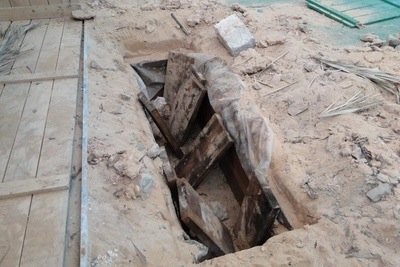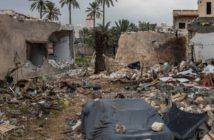Gatestone Institute
by Irfan Al-Alawi

Where are the protests form the media, from the United Nations and UNESCO, from the so-called human rights groups, from the historical preservation societies?
Radical Islamist vandalism of irreplaceable cultural patrimony – including the legacy of Muhammad and other prominent early Muslims – continues, following recent attacks by Saudi-inspired Wahhabis, known incorrectly as “Salafis,” on spiritual Sufi monuments in Egypt, Libya, and Mali. In the past, Wahhabi despoliation has included devastation of the cemeteries where lay the remains of the family and companions of Muhammad, as well as countless distinguished figures in the ensuing 1,300 years of Islamic history.
The bombing of the Bamiyan Buddha statues in Afghanistan by the Taliban and Al-Qaida in 2001 was perceived by non-Muslims as shocking, but as no more than an assertion of extremist Muslim supremacy. Moderate Muslims have a greater understanding of the perversity and danger of such depredations. Wahhabis and other fundamentalists like them have accumulated a long catalogue of desecration and plunder – predominantly at Islamic locations.
The grave Sidi al-Suwayri, Libya.
Wahhabi ideological justification for these crimes is aberrant. They claim that placement of grave markers, erection of tombs and shrines, decoration of mosques, and protection of pre-Islamic or other non-Islamic landmarks may induce Muslims to commit the sins of idolatry and polytheism. Maintenance of any especially attractive sacred structures is therefore prohibited by the Wahhabis, who from the beginning of their activities in the 18thcentury advocated that they be obliterated. Mosques should be plain, but may be overbearing, obtrusive, weirdly modernistic, and intimidating in Muslim and non-Muslim lands where Wahhabis seek influence. Wahhabis accuse the global majority of Muslims of “worshipping” the Prophet Muhammad and saintly Muslims rather than Allah alone, and thereby becoming apostates deserving of execution.
Such twisted beliefs are relatively new; they only appeared in the mainstream of Muslim thought 250 years ago. Non-Muslims predictably find this destructive frenzy incomprehensible; it is probably for this reason that few non-Muslims realize that the majority of victims of Islamist terrorism are so far Muslims.
Wahhabi-Saudi wrecking and pillaging of Muslim cultural treasures was first noticed at the end of the 18th century after they erupted from central Arabia into Iraq. They sacked and looted the tomb of Imam Husayn, the grandson of Muhammad, in the Shia Muslim holy city of Karbala, and besieged Najaf, the location of the shrine of Imam Ali, the cousin and son-in-law of Muhammad, and progenitor of Shi’ism. But they failed to conquer Najaf.
They then headed south and west to the Hejaz district of Arabia, which includes Mecca and Medina. There, in the early 19th century, they killed and destroyed every person and thing of which they disapproved. They robbed their way across the landscape, seizing the rich treasures presented for centuries to the mausoleum of Prophet Muhammad at the Prophet’s Shrine in Medina.
For a time, they were driven out of Mecca and Medina by the Ottomans, but after the House of Saud and the Wahhabi sect retook the Islamic holy cities in 1924-25, they again set about, with considerable determination, eliminating the most honored graveyards, houses, and mosques associated with Muhammad.
The Wahhabis turned the building in Mecca where Muhammad was born into a cattle market, then a library. The grave of Muhammad’s mother, Amina Bint Wahb, was bulldozed, soaked with gasoline and repeatedly set afire. The home of Khadija, the first wife of Muhammad, in which five of his children were born, was covered with sand and later by public toilets – a grotesque act intended to discourage Muslims from praying there, as Islam does not permit worship (of Allah alone – not Muhammad, his wives, or his offspring) in a place where the odors of human waste are present.
Wahhabi wrecking crews have also torn down historic mosques in Medina, and Wahhabi terrorist acolytes have bombed Sufi and Shia structures in Iraq and South Asia. The Wahhabi fanatics even tried to destroy the Ka’bah, the cubical building inside the Grand Mosque at Mecca; and they still threaten to remove the green dome from the Prophet’s Shrine in Medina. If their malign fantasies were fulfilled, they would take the body of Muhammad out of the Shrine and dump it in an unmarked grave. They shrugged with indifference at the loss of exquisite Ottoman mosques during the Balkan Wars of the 1990s. They would gleefully level the Taj Mahal. They would not hesitate to blow up the Egyptian Pyramids and Babylonian palaces and temples. They would tear down the Great Wall of China. They would reduce the pre-Columbian temples of Mexico, Central, and South America to rubble, or any other pre-Islamic structures.
The Wahhabi assault on the legendary, beloved Islamic center of Timbuktu in Mali, during July of this year, was probably their most surprising recent offense. They have now reached Morocco, however, the pearl of Sufism, and one of the outstanding sources of Islamic civilization. As reported by BBC News on October 18, Wahhabis have eradicated pre-Islamic stone carvings in the High Atlas mountains, dated at 8,000 years before the present, and depicting the sun as a god. These petroglyphs were created before the arrival of the Phoenicians in the territory.
Leaders of the Berber Amazigh people who live in the area, south of Marrakesh, trace the ravaging of the incised stones to Wahhabi penetration of the Berber zone of Mali and their subsequent infiltration into Morocco. The local inhabitants report that the Wahhabis claim the survival of any pre-Islamic art, architecture, or other antiquities denies the Muslim conquest of the land. In this way, they most resemble those who shelled the Bamiyan Buddhas with dynamite and anti-aircraft weapons.
The shrine of Aisha Manoubia, in Tunisia, before being burned down.
Meanwhile, in Tunisia, on Tuesday, October 16 – in the early morning of the first day of the Muslim hajj, or pilgrimage, month – a band of Wahhabis burned down the shrine of Sayyida Aisha Manoubia in La Manouba, a suburb of the national capital, Tunis. Sayyida Manoubia was a 13th century female Sufi renowned in North Africa. A second edifice dedicated to her, but located in Tunis itself, has so far been spared. Sayyida Manoubia was a disciple of the distinguished mystic Abul Hassan Al-Shadhili (1196-1258); she was a scholar of Islamic traditions and law. Al-Shadhili named her to head the Shadhiliyya Sufi order, which he founded – and which became one of the most influential metaphysical currents within Islam. From Muslim Morocco, Shadhilism deeply influenced Jewish and Christian mysticism in Spain. Sayyida Aisha Manoubia is considered an exemplary Muslim woman for her religiosity as well as for her assertion of gender equality. It is said, in an important episode in Islamic history, that she had did not hesitate to pray in mosques alongside men.
Where are protests by the media? Where are the protests from the United Nations and UNESCO? Where are protests by so-called human rights groups? Where are protests by historical preservation societies? The Wahhabi effort to halt their marauding across North Africa would best be led by traditional Muslims as well as local officials, but with the loud, vocal, unceasing support of international personalities and bodies who, at the moment, merely claim they are committed to the preservation of “world heritage sites.” This unchecked Wahhabi rampage must be stopped.
.






